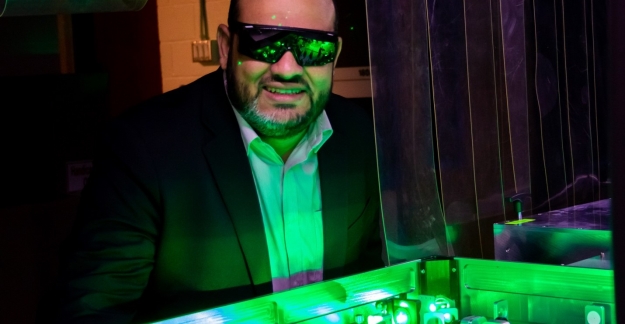Optical switching at file speeds opens door for ultrafast, light-based electronics and computer systems College of Arizona physicists led a world staff in reaching optical switching of a lightweight sign at attosecond speeds to succeed in beforehand unattainable information switch speeds. An attosecond is one quintillionth of a second.
By Logan Burtch-Buus, College Communications
Mohammed Hassan College of Arizona Assistant Professor of Physics and Optical Sciences Mohammed Hassan Mohammed Hassan
Think about a house laptop working 1 million instances quicker than the most costly {hardware} available on the market. Now, think about that stage of computing energy because the trade normal. College of Arizona researchers hope to pave the way in which for that actuality utilizing light-based optical computing, a marked enchancment from the semiconductor-based transistors that presently run the world.
“Semiconductor-based transistors are in all the electronics that we use in the present day,” mentioned Mohammed Hassan, assistant professor of physics and optical sciences. “They’re a part of each trade – from children’ toys to rockets – and are the principle constructing blocks of electronics.”
Hassan lad a world staff of researchers that revealed the analysis article “Ultrafast optical switching and information encoding on synthesized mild fields” in Science Advances in February. UArizona physics postdoctoral analysis affiliate Dandan Hui and physics graduate pupil Husain Alqattan additionally contributed to the article, along with researchers from Ohio State College and the Ludwig Maximilian College of Munich.
Semiconductors in electronics depend on electrical indicators transmitted through microwaves to change – both enable or stop – the stream of electrical energy and information, represented as both “on” or “off.” Hassan mentioned the way forward for electronics will likely be based mostly as a substitute on utilizing laser mild to manage electrical indicators, opening the door for the institution of “optical transistors” and the event of ultrafast optical electronics.
Because the invention of semiconductor transistors within the Forties, technological development has centered on rising the pace at which electrical indicators might be generated – measured in hertz. Based on Hassan, the quickest semiconductor transistors on the planet can function at a pace of greater than 800 gigahertz. Information switch at that frequency is measured at a scale of picoseconds, or one trillionth of a second.
Laptop processing energy has elevated steadily for the reason that introduction of the semiconductor transistor, although Hassan mentioned one of many major issues in growing quicker know-how is that the warmth generated by persevering with so as to add transistors to a microchip would finally require extra power to chill than can go by way of the chip.
Of their article, Hassan and his collaborators focus on utilizing all-optical switching of a lightweight sign on and off to succeed in information switch speeds exceeding a petahertz, measured on the attosecond time scale. An attosecond is one quintillionth of a second, which means the switch of knowledge 1 million instances quicker than the quickest semiconductor transistors.
Whereas optical switches had been already proven to attain info processing speeds quicker than that of semiconductor transistor-based know-how, Hassan and his co-authors had been capable of register the on and off indicators from a lightweight supply taking place on the scale of billionths of a second. This was completed by benefiting from a attribute of fused silica, a glass typically utilized in optics. Fused silica can instantaneously change its reflectivity, and through the use of ultrafast lasers, Hassan and his staff had been capable of register adjustments in a lightweight’s sign on the attosecond time scale. The work additionally demonstrated the potential of sending information within the type of “one” and “zero” representing on and off through mild at beforehand unimaginable speeds.
“This new development would additionally enable the encoding of knowledge on ultrafast laser pulses, which might improve the information switch pace and could possibly be utilized in long-distance communications from Earth into deep area,” Hassan mentioned. “This guarantees to extend the limiting pace of knowledge processing and data encoding and open a brand new realm of knowledge know-how.”
The challenge was funded by a $1.4 million grant awarded to Hassan in 2018 by the Gordon and Betty Moore Basis, a corporation that goals “to create optimistic outcomes for future generations” by supporting analysis into scientific discovery, environmental conservation and affected person care. The article was additionally based mostly on work supported by america Air Drive Workplace of Scientific Analysis’s Younger Investigator Analysis Program.
Additional information A video rationalization of the challenge might be discovered on YouTube.
Share
